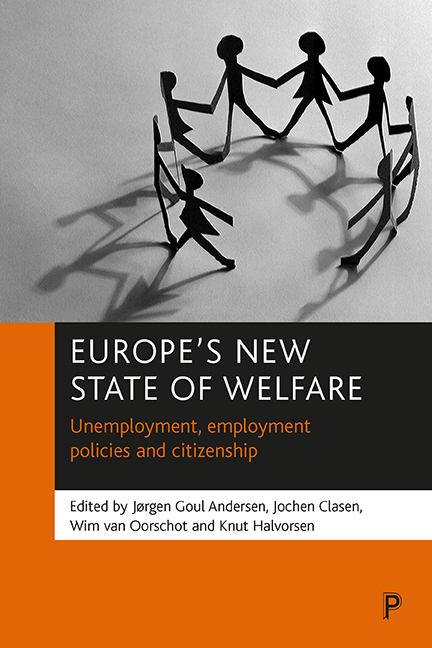Book contents
- Frontmatter
- Contents
- Notes on contributors
- Glossary
- Preface
- one Changing labour markets, unemployment and unemployment policies in a citizenship perspective
- two Employment and unemployment in Europe: overview and new trends
- three Unemployment and unemployment policy in the UK: increasing employability and redefining citizenship
- four To be or not to be employed? Unemployment in a ‘work society’
- five France: the impossible new social compromise?
- six Labour market participation in the Netherlands: trends, policies and outcomes
- seven Is high unemployment due to welfare state protection? Lessons from the Swedish experience
- eight Denmark: from the edge of the abyss to a sustainable welfare state
- nine Unemployment and (un)employment policies in Norway: the case of an affluent but oil-dependent economy: the paradox of plenty?
- ten Unemployment and unemployment policy in Finland
- eleven Slovenia’s navigation through a turbulent transition
- twelve Unemployment and unemployment policy in Switzerland
- thirteen Work, welfare and citizenship: diversity and variation within European (un)employment policy
- References
- Index
- Also available from The Policy Press
two - Employment and unemployment in Europe: overview and new trends
Published online by Cambridge University Press: 20 January 2022
- Frontmatter
- Contents
- Notes on contributors
- Glossary
- Preface
- one Changing labour markets, unemployment and unemployment policies in a citizenship perspective
- two Employment and unemployment in Europe: overview and new trends
- three Unemployment and unemployment policy in the UK: increasing employability and redefining citizenship
- four To be or not to be employed? Unemployment in a ‘work society’
- five France: the impossible new social compromise?
- six Labour market participation in the Netherlands: trends, policies and outcomes
- seven Is high unemployment due to welfare state protection? Lessons from the Swedish experience
- eight Denmark: from the edge of the abyss to a sustainable welfare state
- nine Unemployment and (un)employment policies in Norway: the case of an affluent but oil-dependent economy: the paradox of plenty?
- ten Unemployment and unemployment policy in Finland
- eleven Slovenia’s navigation through a turbulent transition
- twelve Unemployment and unemployment policy in Switzerland
- thirteen Work, welfare and citizenship: diversity and variation within European (un)employment policy
- References
- Index
- Also available from The Policy Press
Summary
Introduction
This chapter provides a broad comparative overview of trends and patterns in employment and unemployment in European countries as a reference point for the country-specific analyses of Chapters Three to Twelve. It is largely descriptive, but also examines to what degree unemployment levels and patterns in Europe still fit the expectations from the economic ‘standard interpretation’ of structural unemployment described in Chapter One.
The first section contains a brief overview of main findings in the comparative economic literature, and the following section assesses the new picture of unemployment in Europe in the early 2000s, as compared to the mid-1990s. The remaining sections examine the changes in labour-force participation, the structure of unemployment, and discuss employment precariousness, living conditions and citizenship.
The chapter is based almost exclusively on international comparative statistics (that is, on the ILO definition of unemployment, mainly on survey-based measurement, and on OECD corrections and modifications). Although other international statistics may in some respects be superior (see Sorrentino, 2000; Threlfall, 2000), the differences are increasingly small, and OECD provides the most comprehensive, easily accessible and updated data set, especially when we also want to compare Europe and US. As international statistical comparability is sometimes obtained at the cost of data validity, country-specific chapters (Chapters Three to Twelve) will, when necessary, comment on differences between international and national statistics.
Empirical findings from the comparative economic Literature
The ‘standard interpretation’ discussed in Chapter One represents a logically coherent paradigm for interpretation of unemployment problems and for formulation of policy solutions. Although policy recommendations rooted in this paradigm are often not followed, a comprehensive alternative paradigm currently does not exist. Even the employment strategy of the EU, at the level of diagnosis, represents a variation of that paradigm rather than a genuine alternative. As a paradigm – exclusively emphasising the supply side (Ljungqvist and Sargent, 1996) – it does not easily lend itself to empirical testing. And even though the sub-field of labour economics is highly empirical, for instance, it should come as no great surprise that many theoretical propositions rest more on strong theoretical grounds than on strong empirical evidence (Holmlund, 1998; Calmfors and Holmlund, 2000).
- Type
- Chapter
- Information
- Europe's New State of WelfareUnemployment, Employment Policies and Citizenship, pp. 21 - 58Publisher: Bristol University PressPrint publication year: 2002



